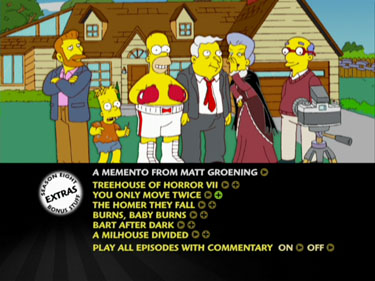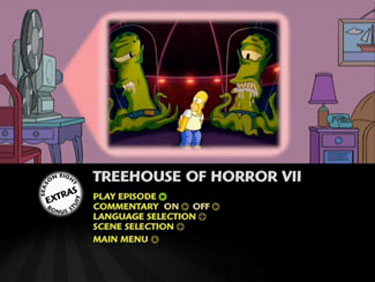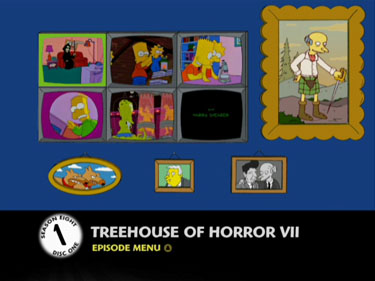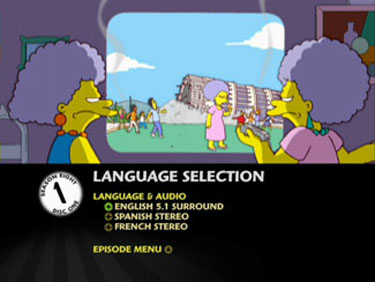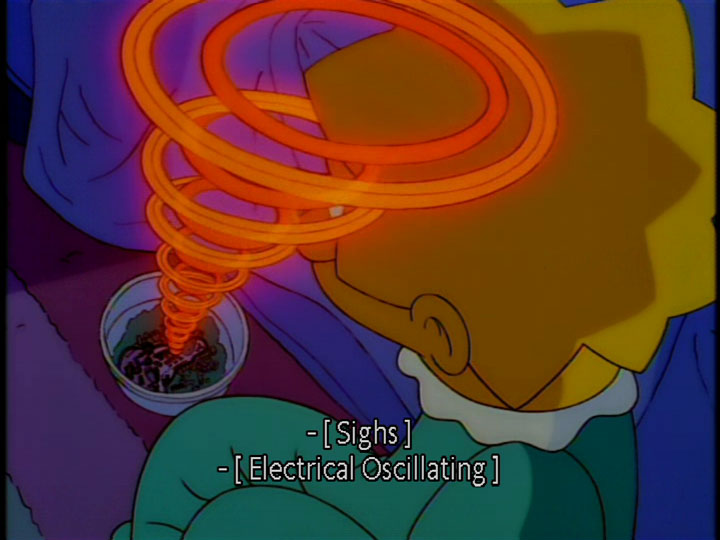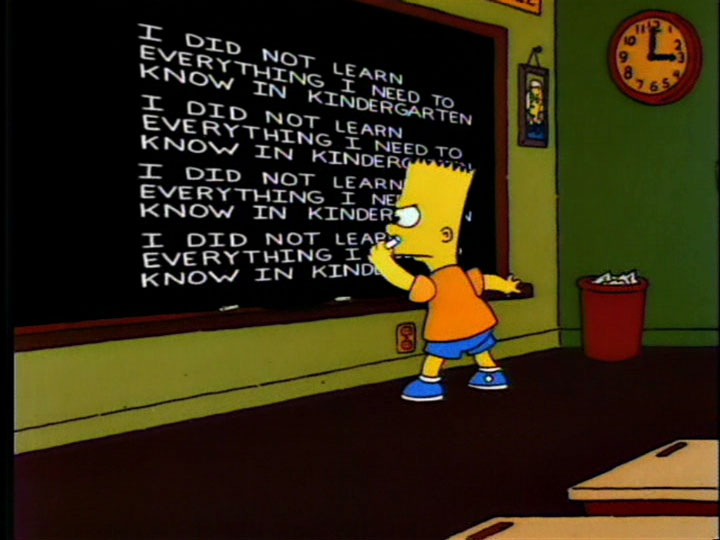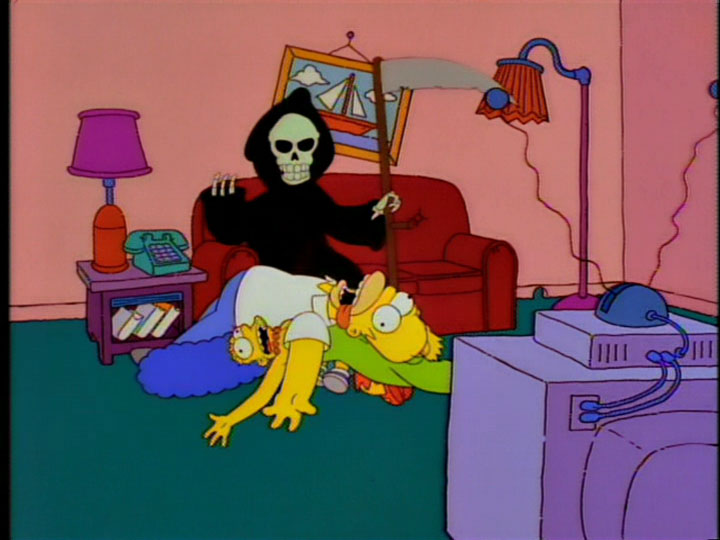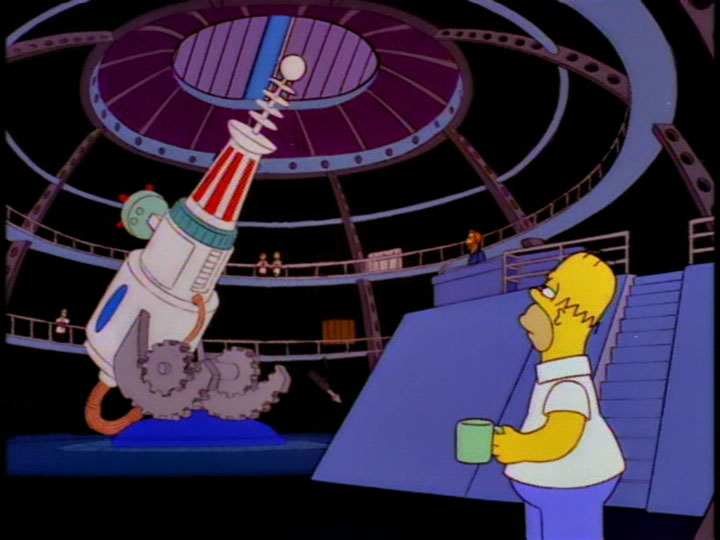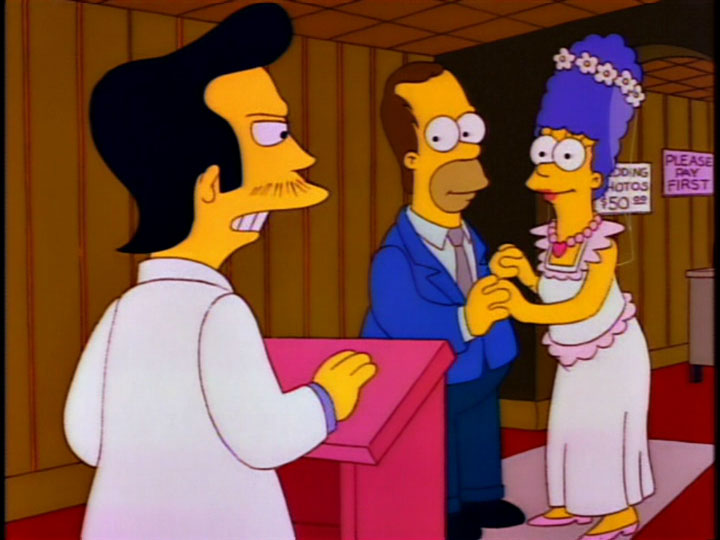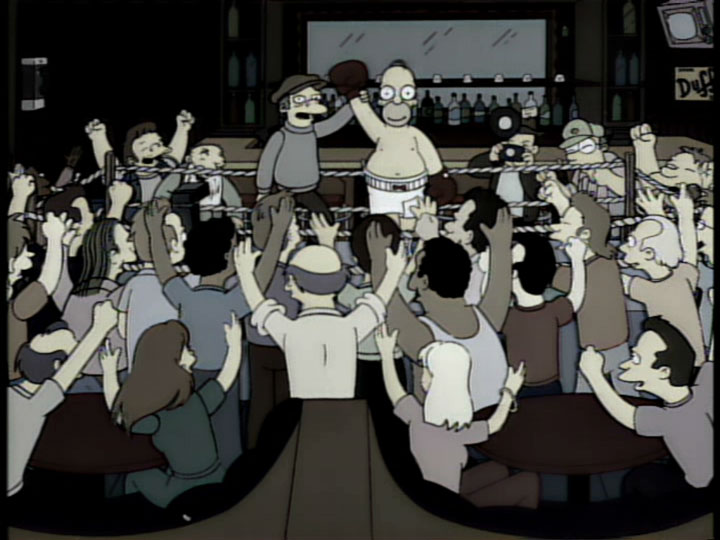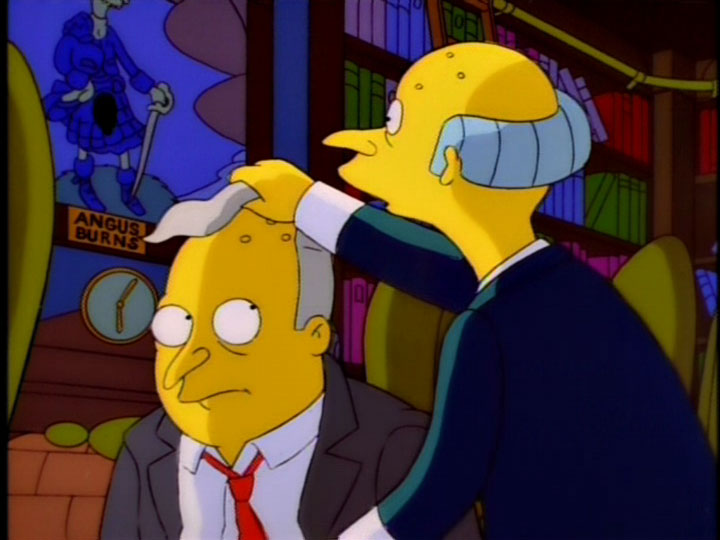![]()
![]()

![]()
![]()

created by Matt Groening
(Season Eight) 1996
Matt Groening generated such a massive cult
following with his landmark series “The Simpsons” (1989) that the popular TV
show recently began its eighteenth season and, as of a couple years ago,
became the longest running comedy series in television history. While it’s
difficult to overestimate the series’ obvious fame, I think many fans fail
to acknowledge the show’s cultural significance over the past sixteen years.
“The Simpsons” is easily the most iconic phenomena of recent times--a series
that possesses universal appeal and a worldwide audience. Groening and his
teams of extremely talented writers and animators (many of whom are replaced
every several years) have parodied some of the finest examples of art in
almost every imaginable medium, touched on socially relevant issues through
clever satire, and revitalized post-modernism in the most unexpected form.
“The Simpsons” has given audiences plenty more than what one would typically
expect from a comedy.
Groening’s deceptively simple premise of a middle-class family of five
dealing with everyday life establishes the perfect foundation for North
American audiences to immediately identify with. Homer is the clueless, but
lovable father; Marge, the doting mother; Bart, the rebellious pre-teen;
Lisa, the brainy sister; and Maggie, the all-but-ordinary baby. Admittedly,
I’ve reduced these roles to simple stereotypes for the purpose of this
review, but the aforementioned characters each embody at least a single
quality that everyone can identify in their respective family (therein lies
a considerable portion of the show’s appeal).
The setting for the series is Springfield, a fictional town that easily
calls to mind the prototypical urban backdrop. Here Groening sets the stage
for one of the most fascinating locales one could possibly imagine. But
rather than flashy aesthetics, it’s the simple touches that often make the
most difference in Springfield. Examining the Simpson family home reveals
the tremendous detail that animators and concept artists have put into the
endlessly imaginative series. Marge’s kitchen curtains with the infamous
corncob print, Bart’s Krusty-the-Clown alarm clock, and the often crooked
painting of a sailboat that hangs in the family room are just a few of the
subtle touches that contribute to the feel of an authentic home environment.
The fine details are hardly confined to the Simpson residence and extend
throughout the city to mold Groening’s expansive cartoon universe.
To bring the writers’ vision to life, animators have distinguished “The Simpsons” with an unmistakable vibrant style. The emphasis on vivacious
primary colors calls to mind Jean-Luc Godard’s famous use of cinemascope in
the 1960s. It wouldn’t be surprising if Groening and his animators were
influenced by Godard given their vast knowledge of cinema, which dates back
to Fritz Lang’s “Metropolis” (1927) (see the oscillating rings in the
subtitle sample). But beyond all instances of presumable inspiration, the
animators should be recognized for consistently experimenting with the
hand-drawn medium. The integration of 3D and live-action is impressive to
some degree (these episodes were created in the mid 1990s); however, it’s
the mastery of fluid movement that’s particularly astounding. Groening’s
characters move about with actions and reactions that ring of accuracy--an
integral source for the show’s humor. In a scene where Homer eats an
extremely spicy pepper, the humor lies solely in the animator’s ability to
convey the unexpected pain Homer experiences. Other animated shows often
rely too much on a clever quip or precise staging to generate laughter, but
animators working on “The Simpsons” have the sound judgment to carefully
balance their methods of delivery.
Above all else, the success of the series is shaped by Groening’s ability to
seamlessly integrate art and satire. Having paid homage and relentlessly
parodied numerous classic films including “Citizen Kane” (1941), “2001: A
Space Odyssey” (1968), and “The Shining” (1980), “The Simpsons” has renewed
the excitement and philosophy that was originally generated by these very
subjects. Audiences are able to draw what they choose from the stabs at
politics (i.e. Bill Clinton) and blind traditions (i.e. Whacking Day), but
the persistence in proposing social and cultural re-evaluation is always
ingrained in every single episode.
With new executive producers onboard for season 8, there is a definite shift
in focus towards supporting characters and camaraderie in unlikely places.
Most notably, Lenny and Carl’s familiar banter in later seasons would
originate here. Other incidences include Homer befriending Mr. Burns during
a company outing, Lisa and Nelson briefly becoming an item, and Moe offering
to manage Homer’s temporary boxing career. These episodes still revolve
around various members of the Simpson family, but it’s clear the producers
desired a new direction for the series. More supporting characters were
created (i.e. Disco Stu) and older characters (i.e. Edna Krabappel) received
more airtime.
Season eight’s “El Viaje Misterioso de Nuestro Homer” (1997) is a
breakthrough episode for the series and one that showcases a variety of
impressive techniques. It’s a relatively bizarre chapter in “The Simpsons”
library, but it’s a personal favorite of mine because of its spiritual tone
and obvious departure from typical scripts and animation (if there is such a
thing in “The Simpsons”). To complement the episode’s surreal hallucinatory
sequence and psychedelic imagery, animators have made use of graphical
continuity and a series of events that appear to be inspired by the work of
artist Salvador Dali. But aside from the visuals, issues of guidance and
meaning are resonant and considerably more message-driven than one would
expect from an episode of “The Simpsons.” This is enhanced by the voice of
guest star Johnny Cash (as the coyote Homer encounters in his dream), which
encourages an aura of folklore. Contrary to the popular belief of skeptical
parents, there are moments in the series with profound morality.
Poster
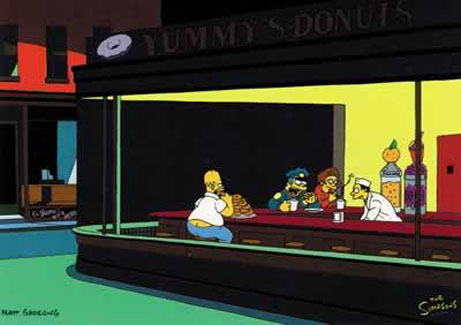 |
Television Premiere: December 17th, 1989
Reviews More Reviews DVD Reviews
DVD Review: 20th Century Fox (Collector's Edition) - Region 1 - NTSC
Big thanks to Kurtis Beard for the Review!
| DVD Box Cover |
|
CLICK to order from: |
| Distribution |
20th Century Fox Region 1 - NTSC |
|
| Runtime | 570 min | |
| Video |
1.33:1 Original Aspect Ratio |
|
|
NOTE: The Vertical axis represents the bits transferred per second. The Horizontal is the time in minutes. |
||
| Bitrate |
|
|
| Audio | Dolby Digital 5.1 (English), Dolby Stereo (French), Dolby Stereo (Spanish) | |
| Subtitles | English, Spanish | |
| Features |
Release Information: Studio: 20th Century Fox Aspect Ratio:
Edition Details: Chapters 6x2 |
|
| Comments |
Video: The video maintains the original broadcast ratio of 1.33:1, which is to be expected for an animated series. The image quality of the episodes range slightly, but in general, is decent and certainly superior to the video that is seen during original broadcasts and re-runs. Colors are vibrant and luminous, particularly in shades of yellow and blue, which is an advantage for the extensive palette used by animators. Brightness and contrast is sufficient and from memory, looks as though it’s been improved since the original broadcasts. The instances of damage are rare, but there are occasional flecks and evidence of wear. As usual, the animation looks absolutely stunning and remarkably fluid (a standard that’s been maintained since the first couple of seasons). In the “Treehouse of Horror VII” episode, look for the impressive overhead shot when Homer is fishing just prior to being abducted by aliens, Kang and Kodos. Audio: The audio is presented in the form of a crisp Dolby Digital 5.1 track. I’m unsure of the track used in the original broadcasts, but the 5.1 is an adequate mix. Dialogue is rarely overpowered by background noise and the soundtrack is well expressed (a must for the occasional classic tune). The track is never particularly overbearing, but more authentic in creating a life-like environment. The sound designers have accomplished very fine work here and again, a standard of excellence has been maintained. Menus and Packaging: Season eight can be purchased in the packaging shaped like Maggie’s head or the classic foldout, custom cardboard box. Personally, I think the traditional box packaging is more economical, but for collectors, the unique ‘head’ casing is great departure from the standard box shape. Animated menus have been cleverly designed with bits of humor and easy navigation. The only problem I had was with the subtitles, which were not listed in the language selection menu. While briefly attempting to enable them in several different episodes, I could only get them to work if a commentary track was playing. Extras: The most substantial extra in this set and almost all the previous seasons are the commentary tracks that accompany every episode. Contributors to the tracks vary with each episode and generally include episode writers, producers and directors, voice actors, occasional guests, and more often than not, creator Matt Groening. For those who have not yet experienced the commentaries on previous DVD releases of “The Simpsons,” there are endless insights to various processes of production and rarely any moments of silence. The participants consistently reveal their inspiration for specific scenes and possible allusions that many audiences may have missed. These tracks are amongst the most entertaining commentaries that I’ve encountered. Secondly, and of particular interest to students of animation, are a series of storyboards and animatics with commentary that reveal the motivation behind specific camera angles and direction of motion. Deleted scenes are also included. It’s often obvious why these scenes were removed from their respective episodes. But, in every few of these scenes, there are moments of substantial humor. Lastly, there is a short featurette that chronicles the construction of a home that was built to reflect the general appearance and proportion of the Simpson’s humble abode. The house is then given away in a contest. |
DVD Menus
|
|
|
|
|
|
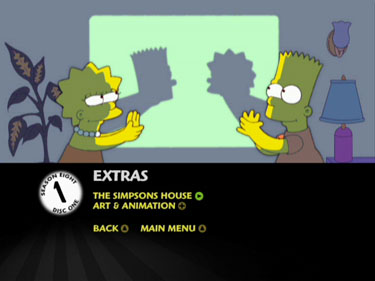 |
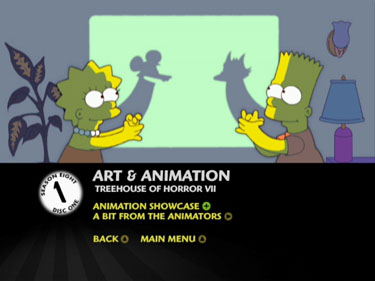 |
Screen Captures
Subtitle Sample
|
|
|
|
|
|
|
|
|
|
|
|
|
|


